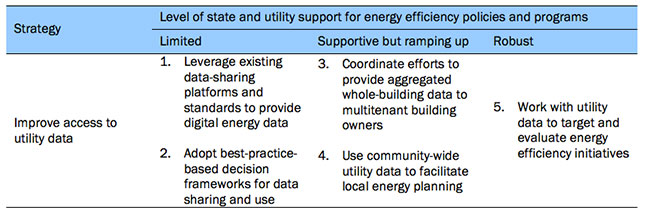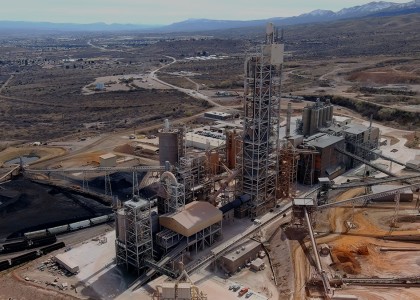This web page is part of a series on how local governments and utilities can collaborate to advance energy efficiency. Supplementing ACEEE’s previous work on improving access to energy usage data, this page outlines a strategy of providing usage data across sectors of the community to encourage energy efficiency investments.[1]
Access to energy usage data is an important step in making communities more energy efficient.
Usage data can help establish baseline performance, identify times or usages associated with high energy costs, improve building performance, and measure performance after energy efficiency interventions.[2] Data access enables both local governments and utilities to evaluate and improve delivery of energy efficiency programs and to support community efforts to reduce consumption and reach sustainability goals.
Cities are in a unique position to advocate for and facilitate access to utility-held energy usage data. While this fact sheet focuses on voluntary building-level and community-wide energy usage data sharing, local mandates for benchmarking and data transparency have also been found to spur city–utility partnerships for improved data access.[3] Regardless of the approach, data access strategies are enhanced when they are designed to encourage building owners to implement energy efficiency measures.
The extent to which city–utility partnerships will be successful largely depends on state policy and utility support for energy efficiency. Table 1 outlines partnership strategy using five tactics appropriate for varying state policy contexts. The tactics should be thought of as options that build on one another. The ones in the first two columns will still be effective in robust energy efficiency states, but certain strategies will be most effective when leveraging strong, utility-led efficiency programs.
Table 1. Tactics for local government-utility partnerships (based on level of state and utility support)
Tactics
1. Leverage existing data-sharing platforms and standards to provide digital energy data. Easily accessible information about energy consumption can encourage better energy management in homes, large buildings, and entire communities. Cities that lack strong policies or programs to support energy efficiency can partner with utilities to leverage existing data-sharing platforms and standards to make data available and user friendly. Cities can encourage their local utilities to adopt online services that automatically upload usage data to standardized customer reports, benchmarking software, or other energy management tools. One such common standard is the industry-led effort, ENERGY STAR® Portfolio Manager®. Created by the EPA, this online tool pulls from utility data and allows building owners to measure and track energy and water consumption as well as greenhouse gas emissions in an easily accessible format. The tool can be used for benchmarking the performance of one building or a whole portfolio of buildings. Local governments and utilities can also rely on the Department of Energy’s Building Energy Data Exchange Specification (BEDES) system for adopting common terms and definitions for energy data to facilitate data sharing.
2. Adopt best-practice decision making frameworks for data sharing and use. Data-sharing practices can be designed in a way to protect the anonymity of specific users while providing building owners or other local stakeholders with useful information on energy use and opportunities to improve performance across communities. To encourage utilities to provide customers and third-party service providers with digital access to energy data, local governments can work with utilities to adopt guidelines that specify the conditions for data sharing under particular use cases.[4] For example, local governments can work with utilities to set a threshold number of accounts or maximum percentage of energy use from a single customer required to allow for sharing of aggregated data scrubbed of identifying characteristics. While sharing data at the account level or in aggregated form can involve privacy concerns, best practices for data science and experiences from other disciplines and industries can inform customer privacy guidelines. [5] Recognizing the shared benefits of using energy data to improve efficiency, utilities and local governments can also work together to develop mechanisms for ratepayers to authorize automatic disclosure of their energy data to third parties. Data-sharing agreements between utilities and local governments or third-party service providers outline the data release process, ensure privacy, and limit use of data to specifically outlined purposes.
Additionally, cities can make data in property tax records available to improve building benchmarking. Tax records help verify the square footage of a property.[6] Inaccurate reporting of building size by building owners and managers can impact the benchmarking process. For example, in Washington, DC, only 12% of buildings reported the square footage that was reflected in tax records. [7]
3. Coordinate efforts to provide aggregated whole-building data to multitenant building owners. Local governments and utilities can work together to leverage existing platforms for providing whole-building data and benchmarking services to building owners, both commercial and residential. Building owners are more likely to invest in energy efficiency if they can regularly measure their energy performance, compare it against similar buildings, and estimate potential savings. The ENERGY STAR® Portfolio Manager is the tool that is most commonly used by building owners to track energy consumption and compare the energy intensity of their property to other buildings. To speed up and simplify data entry, some utilities provide automated benchmarking services that upload whole-building energy data into Portfolio Manager. To further encourage action resulting from the provision of data, local governments and utilities can host community-wide challenges to initiate the tracking of energy usage and energy savings investments. The US Department of Energy’s Standard Energy Efficiency Data (SEED) Platform, an emerging industry standard, can be used to share and manage data on the energy performance of large groups of buildings.
4. Use community-wide utility data to facilitate local energy planning. Energy consumption data can also be tracked across sectors within a community to target local planning efforts to save energy and to maximize energy efficiency efforts. Community-level utility data can help track, map, and compare energy usage by sector or geographic area. By establishing baseline measurements, aggregated community-level utility data can drive community-based energy efficiency efforts by informing local energy programs and planning, e.g., by enabling energy savings goals and targeted programs for particular market segments. Local governments can lead by example by facilitating the tracking and disclosure of municipal buildings’ energy usage. In general, local governments can engage with utilities to provide data aggregation in multiple ways and, when possible, share data using a free, regularly updated, user-friendly online portal that includes mapping capabilities. To encourage use of data for a variety of purposes, planners, policymakers, residents, and other community leaders should collaborate to create a virtual data warehouse for public use.
5. Work with utility data to target and evaluate energy efficiency initiatives. Local governments and utilities can use aggregated data to identify energy efficiency opportunities across building portfolios and communities. The layering of energy data with other demographic or building data can help identify and target efforts to customers underserved by current energy efficiency programs, including high energy users. Local governments can encourage the provision of data at smaller geographies with geospatial tags that allow other neighborhood, buildings, and household data to be attached. In some jurisdictions, utilities have begun to maximize energy efficiency investments in the residential and commercial building sectors by targeting incentives to buildings with high energy usage.
Questions to Consider When Identifying Strategies for Your Community
Current state policies and programs offered by utilities are an important factor to consider when identifying the data access tactics most appropriate for your community. Begin by taking a good inventory of what is currently available and what is planned for the near future. Then local governments and utilities should consider additional questions.
For local governments
- Do the major utilities serving this area provide energy efficiency programs to customers? If so, obtain program descriptions and the most recent utility plans.
- Do the major utilities provide data to customers? If so, what data do they provide and in what format? Can the local government make community residents more aware of the data available and put it to better use?
- Do utilities currently support existing data-sharing tools and formats like ENERGY STAR’s Portfolio Manager or Green Button?
- Are voluntary programs or mandates in place for building energy benchmarking and disclosure? If so, how can the data better inform local energy and sustainability planning?
- Does local energy or sustainability planning leverage the use of energy data? For example, are the buildings or neighborhoods with the highest energy use identified and are there strategies for energy reduction?
- How can local government networks help utilities achieve energy savings by providing energy data? These networks may consist of sustainability practitioners, housing providers, community planners, and other local groups that could make use of energy data.
For utilities and program administrators
- How can improved data access help reach energy efficiency goals and improve customer service?
- Are there guidelines in place for the release and use of customer-specific or aggregate energy data under a variety of use cases?
- Is there demand for improved data access among customers, local officials, and community stakeholders?
- Are there existing local government programs or initiatives aimed at reducing energy consumption that could benefit from access to utility data? Can these be used as platforms to publicize data-sharing systems to track energy usage for a variety of customers?
Case Studies
BuildSmart DC
BuildSmart DC is a collaborative effort launched by the government of Washington, DC, and its main utilities, Washington Gas and Pepco. The BuildSmart DC online platform features a visual database profiling the energy use of municipal buildings throughout the city. This tool integrates data from utility bills, utility meters (including interval data from advanced meters, weather stations), and other engineering and building systems, enabling real-time tracking of building energy use across the government building portfolio. The database also provides information on energy efficiency projects completed and in progress. Data are provided in the form of energy use per square foot or aggregated for whole buildings. Users can track and compare energy usage and costs by zip code or neighborhood or over time, as well as building features and certifications.
Tactics Used
-
Leveraged existing data-sharing platforms and standards to provide digital energy data
-
Used community-wide utility data to facilitate local energy planning
-
Worked with utility data to target and evaluate energy efficiency initiatives
For more information : http://www.buildsmartdc.com/
Chicago Energy Data Portal and Map
Under the Retrofit Chicago Initiative, the city of Chicago, ComEd, and Peoples Natural Gas provide access to energy consumption data by census block and neighborhood for households, businesses, and industries. The public dataset, provided in spreadsheet format and through the Energy Data Map, contains variables describing selected characteristics of the census block including population, physical housing, and occupancy. To protect privacy, geographic identifiers for census blocks with fewer than four accounts are displayed at the neighborhood level without further geographic identifiers. The city government uses these data to identify high energy usage areas where energy efficiency resources will be targeted. Whole-building data were used to facilitate the Neighborhood Energy Challenge, in which apartment buildings compete to reduce energy consumption. In addition to the Energy Data Map’s public data, ComEd’s Energy Usage Data tool provides building owners and managers anonymized, aggregated energy data for their multitenant commercial, residential, and industrial buildings. This tool can also automatically upload whole-building energy data into ENERGY STAR’s Portfolio Manager.
Tactics Used
-
Leveraged existing data-sharing platforms and standards to provide digital energy data
-
Adopted best-practice-based decision frameworks for data sharing and use Used community-wide utility data to facilitate local energy planning
-
Coordinated efforts to provide aggregated whole-building data to multitenant building owners
-
Worked with utility data to target and evaluate energy efficiency initiatives
For more information: http://energymap.cityofchicago.org/
Philadelphia’s Building Energy Performance Profiles
The city of Philadelphia works closely with PECO and Philadelphia Gas Works to provide data to building owners and operators to drive reductions in building energy usage. The city recently launched the Energy Reduction Race, a one-year challenge for buildings that have participated in energy benchmarking to reduce their usage by 5%. The Mayor’s Office of Sustainability has also been helping building owners better understand what benchmarking data means for their facilities. It mails building energy performance profiles to every owner, outlining how their building compares to its peers and highlighting utility incentive programs. The sustainability office is currently developing a data visualization tool to improve the usability of this information. It is also testing various services to support building owners who request further assistance in developing energy efficiency retrofit project plans.
Tactics Used
-
Leveraged existing data-sharing platforms and standards to provide digital energy data
-
Adopted best-practice-based decision frameworks for data sharing and combined efforts to provide aggregated whole-building data to multitenant building owners
-
Worked with utility data to target and evaluate energy efficiency initiatives
For more information: http://www.phillybuildingbenchmarking.com/
PG&E Community Data Web Portal
PG&E’s Green Community Project provides energy data to local governments and their representatives through their Community Data Web Portal. Users can freely access data and reports. PG&E worked with ICLEI USA to develop standardized reporting of greenhouse gas emissions associated with electricity and natural gas use in communities to help local governments develop their emissions inventories and climate action plans. Data inform local energy and climate planning by providing metrics on energy consumption, emissions, and energy savings by sector—residential, commercial, municipal, and industrial.
Tactics Used
-
Leveraged existing data-sharing platforms and standards to provide digital energy data
-
Used community-wide utility data to facilitate local energy planning
For more information: http://www.pge.com/mybusiness/environment/whatyoucando/greencommunities/
Contact
Lauren Ross, ACEEE Utilities State and Local Policy Program | (202) 507-4039 | lross@aceee.org
[1] Best Practices for Working with Utilities to Improve Access to Energy Usage Data and
Residential Energy Use Disclosure: A Guide For Policymakers
[2] For more on the different uses and value of benchmarking the energy performance of buildings, see http://www.imt.org/resources/detail/creating-value-from-benchmarking-a-utility-perspective.
[3] For more on building benchmarking and data transparency policies, see http://www.imt.org/resources/detail/map-u.s.-building-benchmarking-policies .
[4] Some common use cases include whole-building benchmarking, community carbon reporting, and community load data (geographically defined, and EM&V).
[5] https://www4.eere.energy.gov/seeaction/publication/regulators-privacy-guide-third-party-data-access-energy-efficiency
[6] https://mitei.mit.edu/system/files/2014-MITEI-Symposium-Palmer-Can-Benchmarking-and-Disclosure-Laws-Provide-Incentives-for-Energy-Efficiency-Improvements-in-Commercial-Buildings.pdf
[7] http://ddoe.dc.gov/publication/green-building-reports
Local Policy Toolkit
- Local Energy Planning
- Local Government Lead by Example
- Local Government-Utility Partnership Strategies
- Community Resilience
- Local Energy Efficiency Policy Calculator (LEEP-C)



